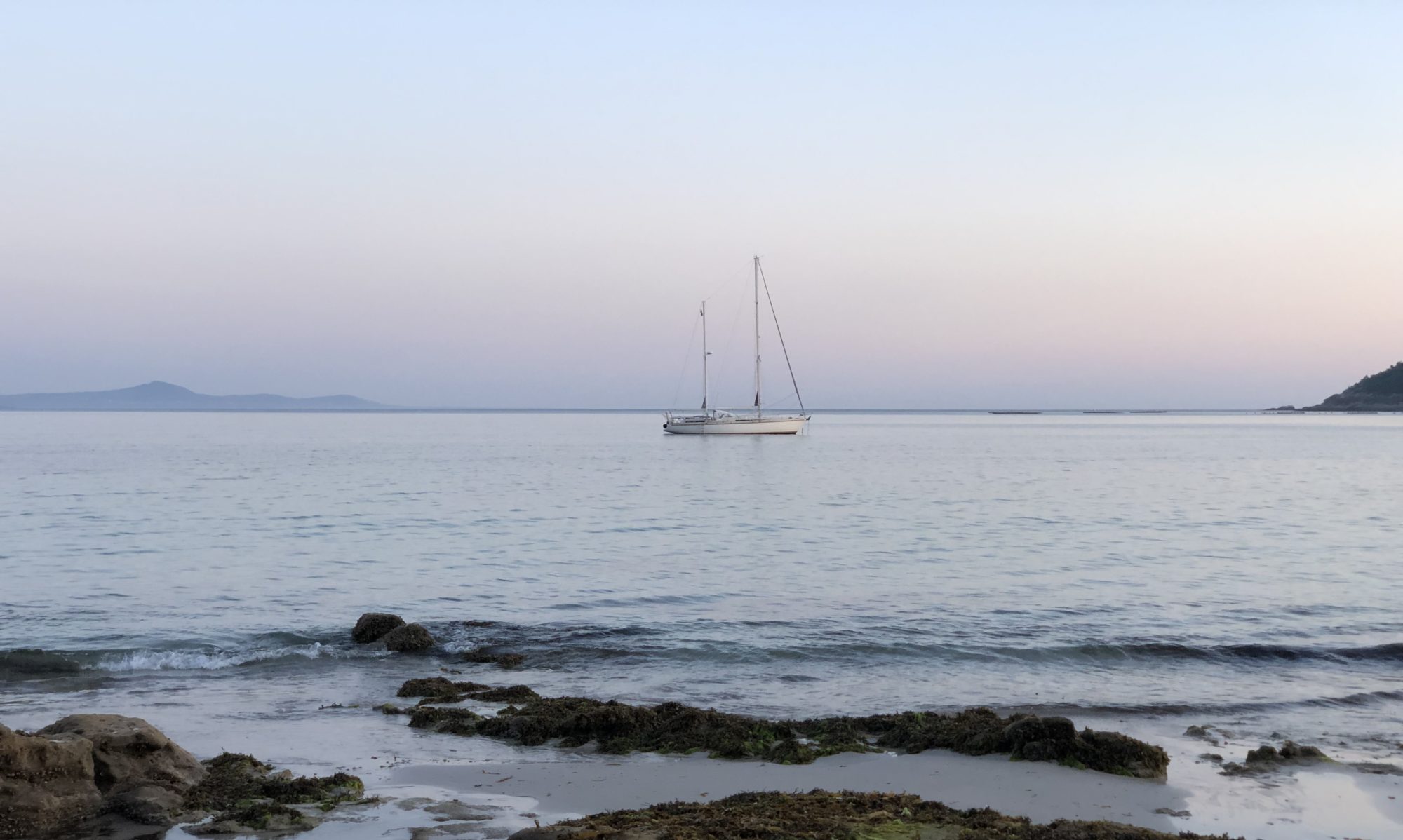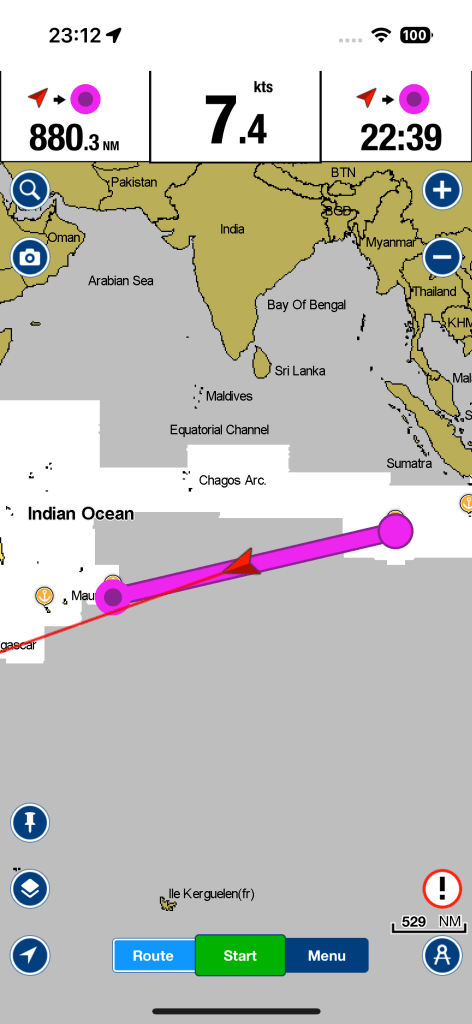Welcome to join us on our sailing from Réunion to South Africa. The journey of 1428 nm took just over ten days and covered all kinds of weather – from almost mirror-like to gale, rain and thunder to sunny days. The day we left was Arthur’s birthday, and below you can see our first sunset on this trip.

We both enjoy the long passages a lot. Despite that, a route that has never been sailed before entails greater uncertainty, and that was the case this time as well. The ”threat” we knew was that around southern Madagascar it could be windy any way, and then we would have to cross the infamous Aghula stream which runs in a north-south direction. The winds, on the other hand, blow for a couple of days in the north-south (same) direction – which is what we want, but then the wind turns and blows against the current – and that is the dangerous thing – then the waves can be 20 meters high at worst. Nobody wants to end up in that, but predicting it ten days in advance is difficult, so you have to have a backup plan, for example, sailing north near Madagascar. Arthur had seen three high pressures in a row, so we hoped the forces of weather would be with us all the way.
What follows is one or a few pictures from each day. The motive is what surrounds us in the Indian Ocean. I connect with a lot of wisdom – it’s like existence is talking to me and showing me what really matters. Join me and slow down, and you too will see the beauty that surrounds us.
We take turns to watch every night. It’s me, Anna, who has the morning shift. I love watching the sunrise. It takes around an hour and is my sacred time.
The next morning starts much brighter. Suddenly everything feels easier.

After half an hour, we have a completely different scene. The sun looks so small, when in fact it is not.

When I look at my pictures afterwards on the computer, I sometimes zoom in on the mysterious core of the sun.

For me, a passage is very much about being with what is – the waves, the wind. The sunrise is a beautiful reminder that we all are given a new chance.
Every day and in every way it is getting better and better. Émile Cloué.
Day 3. See how the contrasts are enhancing each other.

Day 4. The inherent light and energy are stronger than we might think. This is another example of an image that I edited afterwards. This morning was pretty pale, and I was curious to see how the picture would look with a little more colour. I think this is a perfect reminder of our potential, if we raise our energy, there are more ”colours” in all of us. And there is always light somewhere!

Day 5. This was a day we didn’t go outside at all. It was raining, and later we had lightning behind us. No thunder sounds, only lightning flashes.
Day 6. The sun ALWAYS comes after rain. This day we got some fascinating skies. The two first are from the morning and the third one is just after the sunset.



Day 7. Our new passenger has perfect sea legs. I feel like him (or her) when I cook on the high seas and wish I, like the grasshopper, had more arms and legs.

Out at sea, there is both a lot and a little to look at. Consciously, we choose not to spend time watching movies. We see sailing on the seas as a great opportunity to be with ourselves and the surrounding magnificent existence.
One observation is that all animals and birds in the immediate area seek contact. The dolphins are well known for playing at the bow. We haven’t seen any on this trip but on others. They can come from far away and stay for quite some time. There are coming birds from time to time – and they also take the time to fly around the boat for a while. Often I hear them singing from inside the salon, so I go out and greet them. It is always a great honour if they come down to the boat for a rest.
In all oceans, there are schools of flying fish. Small silvery fish flying just above the surface. Often some of them land on the deck. Since they’ve often dried before we find them, I’m not too sure how I feel about it. We have not been able to see them as food that comes from heaven.
Day 8. Do you see the white dot between the stern stays? It is Venus, the evening star, named after the goddess of love and beauty. After the Moon, Venus is the brightest planet, at its peak in the early evening and morning. Venus is a hot planet, 464°, and is about the same size as Earth, with the same proximity to the Sun.

We are in the short time zone known as the blue hour when these two pictures are taken. Almost an hour long before sunset, but much shorter, around ten minutes, after sunset. I can’t see the blue with my eyes, but the camera detects it easily.

Day 9. Every day brings something different. This morning, this big cloud fascinated me.

After just twenty minutes, the sky and clouds looked completely different.

At 5.42 AM the Sun makes entrance.

And three hours later, everything is pure blue. This blue impression was very common in the Pacific – there it was like this day in and day out. In the Indian Ocean, this is a rare sight. This day we had magical sailing in little wind (12 knots) and no waves. In Sweden, we call it champagne sailing – when there are only small ripples on the surface but still enough wind to sail on – a feeling of euphoria.

Day 9. A new morning – a new day with new opportunities.

For a little while, this sunrise created gold on the waves. It was a magical moment. A wave is like an opportunity – they are around us all the time. We always get many chances. Do we see them? I had to zoom in, then they became even more magnificent and obvious.

In the afternoon, I felt that ”something was in the air”, so I went outside to look. The whole sky was filled with birds. Maybe they are not so visible, but they were many. Usually, it’s only one or two at a time.

I could see the clouds quickly building. We were near the centre of a low pressure. We knew it was out there somewhere. Predict Wind, our weather program has six different models. Four of them proposed a southern route and two a more northerly route. We followed the southern route, but it turned out to be the route right into the low pressure. Not so easy to know what is the best choice every time. In any case, it was beautiful.

After an hour the wind changed, and we had to cruise in the rain with the sea towards us.

Day 10. The moon is so quiet and magical. Suddenly it’s just there. We love to sail with a rising moon.

The light feathers high in the sky.

Day 11. This is the day we enter AFRICA, Richards Bay. It started with a fantastic sunset in the stern.

And it ended in rough seas, waiting for a cargo ship to pass through the entrance channel.

Fortunately, it was very calm in the inner harbour. Below is the Q-doc, where all sailors must first go to get their visa permits. The tide is up to two meters here.


The next day, we went over to the nearby Zululand Yacht Club, which has the nice tradition of celebrating all new arrivals with a bottle of sparkling wine. The flowers are Protea, the national flowers of South Africa. Time to celebrate!
With this ”leg” we also completed the 5664 nautical miles sailing of the Indian Ocean. A trip that took us a total of three months, July to October, from Darwin in northwestern Australia to Richards Bay in eastern South Africa.














































